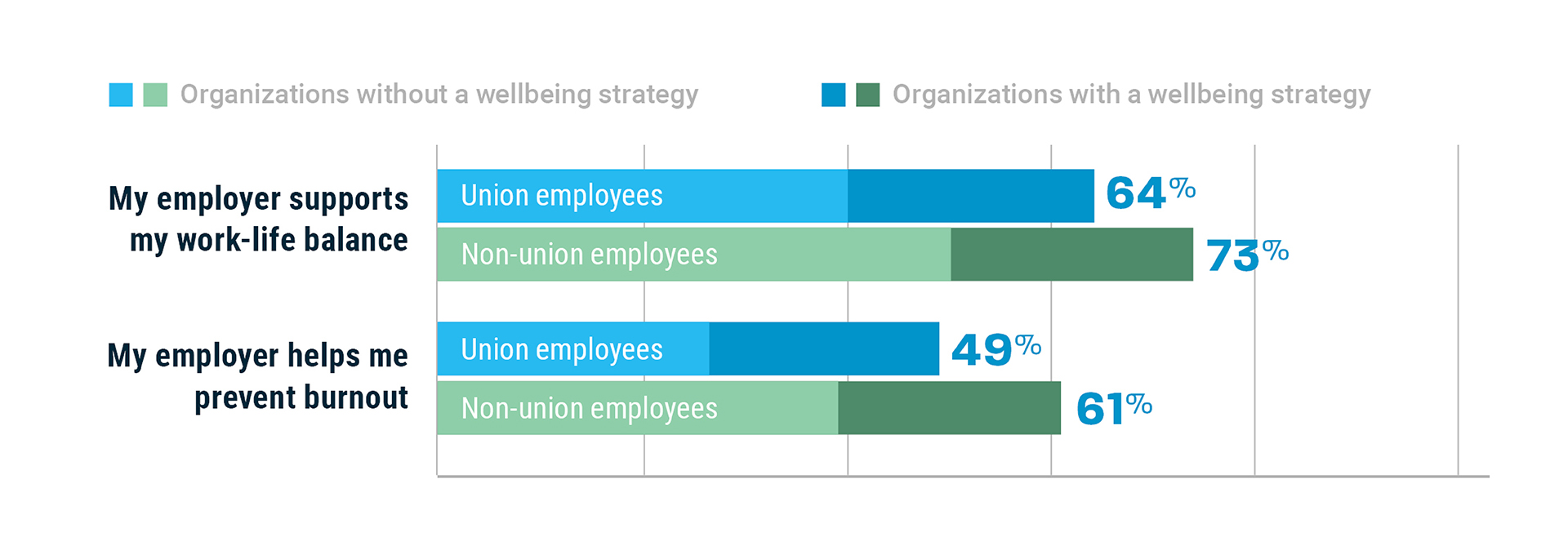What does workplace wellbeing look like when it’s negotiated, not just offered? In unionized workplaces, wellbeing isn’t a perk—it’s a priority shaped through collective voice and formal agreements. The shift from offering benefits to negotiating workforce wellbeing requires a deeper understanding of what a workplace wellbeing strategy truly means.
What defines a workplace wellbeing program?
A wellbeing strategy informs the employer-led offerings that support employees’ physical, mental and emotional health.
These offerings can include:
- Health coverage – medical, dental and vision
- Mental health support – counselling, Employee Assistance Programs (EAPs) and crisis support
- Wellness initiatives – fitness programs, health screenings and nutrition support
- Work-life balance support – flexible scheduling, paid time off and family leave
- Financial wellbeing tools – retirement planning and financial counselling
- Cultural factors – psychological safety, fair processes and employee recognition programs
In unionized workplaces, many of these supports are shaped through collective bargaining. That changes how programs are designed, shared and experienced every day. To maximize impact, organizations should co-design cohesive wellbeing strategies with unions and employees—strategies that reflect the diverse needs of unionized environments and build lasting trust and engagement.
The state of wellbeing in unionized workplaces
One in three Canadian workers—roughly 5.3 million people—belong to a union. That’s a significant part of the workforce whose wellbeing is often negotiated collectively. Statistics Canada reports that 83% of employees covered by a collective agreement had workplace medical or dental benefits, compared with 59.7% of non-union employees.
In our Workplace Wellbeing Report | 2025, Alberta Blue Cross® surveyed 2,000 Canadian workers to understand what drives workplace wellbeing. Our findings show that benefits alone don’t make employees feel supported. Unionized employees often view and experience workplace wellbeing differently. They tend to put greater importance on work-life balance, job security and leadership support for their wellbeing.
- Work-life balance: Only 40% of union employees feel supported in their work-life balance compared with 50% of non-union employees.
- Burnout prevention: Just 27% of union employees say their employer helps them manage or prevent burnout, compared with 39% of non-union employees.
When a clear, relevant wellbeing strategy is in place, those numbers rise:

One union participant shared this view: “Management needs to recognize that we’re human… When they invest in our wellbeing as people, we show up differently for the organization.”
What our report reveals about unionized workplace wellbeing
When we compared responses from unionized and non-unionized employees, we saw a clear pattern. Both groups care about mental and physical health, but they focus on different needs to achieve them.
What unionized workers said they care most about:
- Fairness and respect at work –feeling safe to speak up and knowing their concerns will be heard
- Job stability and predictable workloads – clear scheduling and protection from sudden changes
- Leadership that keeps its word – honouring the commitments made in collective agreements
In comparison, non-union employees placed more value on:
- Flexibility – in when, where and how they work
- Opportunities to learn and grow – through professional development
While this may not be surprising, hearing it directly from union employees is a powerful reminder: wellbeing is about more than individual perks. It’s about stability, trust and fairness—shared values that shape how employees experience their workplace every day.
“The benefits are there on paper, but if leadership doesn’t visibly support what’s been negotiated, it feels like an empty promise.” Union employee, survey participant
For unionized team leaders, understanding this difference is key. When wellbeing strategies reflect collective priorities, they build trust and strengthen engagement across the organization.
Why the difference matters
Union environments work differently, and that has a direct impact on wellbeing.
The collective voice creates accountability
Wellbeing programs are written into formal agreements. This means leadership and unions must work together—and both have skin in the game.
Trust operates differently
When the cohesive workplace wellbeing strategy is visible and consistent, trust in leadership rises—from 67% to 89%. In union settings, that trust is vital because it shapes daily labour-management relationships.
Communication channels are complex
Our survey found that 72% of employees are unaware that a wellbeing strategy is in place—something that should be embedded in the culture. In union workplaces, messages go through more people before reaching workers. Clear, honest communication is critical.
What union members need from a wellbeing strategy
Our 2025 survey shows union members value:
- Meaningful work with a clear purpose – understanding how their work contributes to success
- Visible leadership commitment – leaders who model healthy work habits and respond to feedback
- Protection of personal time – boundaries that prevent work from bleeding into personal time
- Accessible mental health support – benefits that are easy to use and relevant
Collective bargaining as a wellbeing opportunity
Unions have long championed workplace health and safety. Today, they’re also advocating for psychological health and wellbeing.
Across Canada, unions are negotiating for:
- Enhanced mental health coverage beyond EAP programs
- Paid mental health days, separate from sick leave
- Workplace culture commitments in collective agreements
- Joint labour-management wellbeing committees
- Training for supervisors on mental health support
Our data shows union members expect their unions to advocate for wellbeing—and they notice when that advocacy delivers. Without a clear wellbeing strategy, trust drops to 61% in unionized workplaces. This shows that workers view negotiated wellbeing support as a core employment right, not just a perk While the concepts aren’t new, this shift shows that wellbeing has become a defined union priority—part of fairness, safety and dignity at work.
Strengths in unionized workplaces
Unionized environments offer strong structural supports for employee wellbeing:
- Relevant benefits through negotiation – “more” coverage isn’t the goal
- Clearer processes for support – formal representation helps employees access resources
- Built-in feedback loops – regular labour-management meetings create space for dialogue
- Collective advocacy – union representation uplifts employee voices
Where challenges remain
Many union workplaces operate within large, complex organizations. According to Statistics Canada, union coverage is highest in large employers—those with 500 or more employees—where collective agreements must travel through multiple layers of leadership and representation. In these environments, even strong wellbeing strategies can get lost or fail to reach those who need them most. As noted, when wellbeing strategies aren’t visible or effective, the impact on trust is significant.
Even with strong structures, distinct challenges persist:
- Communication breakdowns — many employees don’t know what wellbeing supports are available
- Leadership visibility gaps — when leaders don’t model wellbeing, negotiated benefits lose impact
- Cultural resistance — some industries still stigmatize mental health or using available supports
- Inconsistent implementation — wellbeing support often varies across departments or work shifts
Five effective strategies for workplace wellbeing in union settings
Based on our findings and the unique dynamics of these environments, here are specific actions that create impact:
- Co-create wellbeing strategies with workers and union partners Involve union representatives early. When employees see their union shaping initiatives, trust and engagement increase.
- Train supervisors as wellbeing ambassadors Team leaders bridge upper management and frontline workers. Equip them to support wellbeing while respecting collective agreements.
- Make wellbeing visible everywhere Share updates in union meetings, bulletins, shift briefings and digital channels so everyone knows what’s available.
- Create joint wellbeing committees Give labour-management committees real authority to identify challenges, propose solutions and track progress.
- Close the feedback loop When employees or union reps raise concerns, respond quickly and share what’s changing as a result. Visibility builds trust and satisfaction.
How wellbeing strategies impact union workplaces
When a relevant, supported wellbeing strategy is in place, the results speak for themselves:
- Trust in leadership rises to 89% (from 67% without a strategy)
- Readiness for change rises to 94%
- Employee advocacy for the organization reaches 81%
These strengths and challenges show that wellbeing in union workplaces is as much about relationships as it is about resources.
Key insight: Union environments already have the structures to support wellbeing. The real impact comes when culture, communication and leadership align with negotiated commitments. Wellbeing strategies need to work with collective bargaining structures, not around them.
Learn more in our Workplace Wellbeing Report | 2025
The full report includes:
- Union vs non-union analysis across wellbeing measures
- Regional and industry representation
- Case examples from Alberta-based organizations
- Strategies for leaders of unionized teams
- Key elements of effective workplace wellbeing initiatives
Ready to take your workplace wellbeing strategy further?
Strengthen my wellbeing strategy
This is the second article in our Workplace Wellbeing Report series. Didn’t catch the first one? Learn why workplace culture often beats programs when it comes to true employee wellbeing. Read it here.


